Related Research Articles
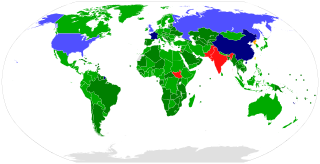
The Treaty on the Non-Proliferation of Nuclear Weapons, commonly known as the Non-Proliferation Treaty or NPT, is an international treaty whose objective is to prevent the spread of nuclear weapons and weapons technology, to promote cooperation in the peaceful uses of nuclear energy, and to further the goal of achieving nuclear disarmament and general and complete disarmament. Between 1965 and 1968, the treaty was negotiated by the Eighteen Nation Committee on Disarmament, a United Nations-sponsored organization based in Geneva, Switzerland.

Nuclear proliferation is the spread of nuclear weapons, fissionable material, and weapons-applicable nuclear technology and information to nations not recognized as "Nuclear Weapon States" by the Treaty on the Non-Proliferation of Nuclear Weapons, commonly known as the Non-Proliferation Treaty or NPT. Proliferation has been opposed by many nations with and without nuclear weapons, as governments fear that more countries with nuclear weapons will increase the possibility of nuclear warfare, de-stabilize international or regional relations, or infringe upon the national sovereignty of nation states.
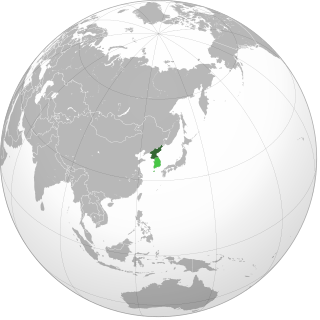
North Korea has a military nuclear weapons program and, as of 2024, is estimated to have an arsenal of approximately 50 nuclear weapons and sufficient production of fissile material for six to seven nuclear weapons per year. North Korea has also stockpiled a significant quantity of chemical and biological weapons. In 2003, North Korea withdrew from the Treaty on the Non-Proliferation of Nuclear Weapons (NPT). Since 2006, the country has conducted six nuclear tests at increasing levels of expertise, prompting the imposition of sanctions.

The Director of Central Intelligence (DCI) was the head of the American Central Intelligence Agency from 1946 to 2004, acting as the principal intelligence advisor to the president of the United States and the United States National Security Council, as well as the coordinator of intelligence activities among and between the various US intelligence agencies.

Taepodong-1 was a three-stage technology demonstrator developed by North Korea, a development step toward an intermediate-range ballistic missile. The missile was derived originally from the Scud rocket and was tested once in 1998 as a space launch vehicle. As a space launch vehicle, it was sometimes called the Paektusan 1.

William D. Gertz is an American editor, columnist and reporter for The Washington Times. He is the author of eight books and writes a weekly column on the Pentagon and national security issues called "Inside the Ring". During the administration of Bill Clinton, Gertz was known for his stories exposing government secrets.

The Central Intelligence Agency, known informally as the Agency, metonymously as Langley and historically as the Company, is a civilian foreign intelligence service of the federal government of the United States tasked with gathering, processing, and analyzing national security information from around the world, primarily through the use of human intelligence (HUMINT) and conducting covert action through its Directorate of Operations. The agency is headquartered in the George Bush Center for Intelligence in Langley, Virginia.

Two rounds of North Korean missile tests were conducted on July 5, 2006. The Democratic People's Republic of Korea reportedly fired at least seven separate missiles. These included one long-range Taepodong-2 missile and short-range Scud derived missiles including the enlarged Nodong missile. The Taepodong-2 was estimated by United States intelligence agencies as having a potential range reaching as far as Alaska, although this missile failed after about 42 seconds of flight.
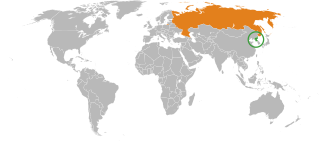
The Soviet Union was the first to recognize North Korea on October 12, 1948, shortly after the proclamation, as the sole legitimate authority in all of Korea. The Soviet Union supported North Korea during the Korean War. North Korea was founded as part of the Communist bloc, and received major Soviet military and political support. The comprehensive personality cult around North Korea's ruling family was heavily influenced by Stalinism. China and the Soviet Union competed for influence in North Korea during the Sino-Soviet split in the 1960s, as North Korea tried to maintain good relations with both countries.
Signals intelligence by alliances, nations and industries comprises signals intelligence (SIGINT) gathering activities by national and non-national entities; these entities are commonly responsible for communications security (COMSEC) as well.
This article deals with activities of the U.S. Central Intelligence Agency, specifically dealing with arms control, weapons of mass destruction (WMD) and weapons proliferation. It attempts to look at the process of tasking and analyzing, rather than the problem itself, other than whether the CIA's efforts match its legal mandate or assists in treaty compliance. In some cases, the details of a country's programs are introduced because they present a problem in analysis. For example, if Country X's policymakers truly believe in certain history that may not actually be factual, an analyst trying to understand Country X's policymakers needs to be able to understand their approach to an issue.
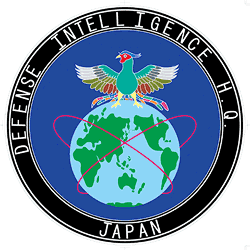
The Defense Intelligence Headquarters is a military intelligence and signal intelligence agency of the Japanese government, under the jurisdiction of the Japanese Ministry of Defense. It is currently one of the biggest Japanese intelligence agencies, with its creation and structure modeled after the American Defense Intelligence Agency.

The Korean People's Army Strategic Force, previously known as the Korean People's Army Strategic Rocket Force, is a military branch of the Korean People's Army (KPA) founded in 2012 that operates surface-to-surface missiles in the nuclear and conventional strike roles. It is mainly armed with ballistic missiles. The inventory includes domestic and Soviet designs.
After the end of World War II, all the Western allies began a rapid drawdown of military forces, including those of signals intelligence. At the time, the US still had a COMINT organization split between the Army and Navy. A 1946 plan listed Russia, China, and a [redacted] country as high-priority targets.

Kwangmyŏngsŏng-1 or Gwangmyeongseong-1 was a satellite allegedly launched by North Korea on 31 August 1998. While the North Korean government claimed that the launch was successful, no objects were ever tracked in orbit from the launch, and outside North Korea it is considered to have been a failure. It was the first satellite to be launched as part of the Kwangmyŏngsŏng program, and the first satellite that North Korea attempted to launch.

Ray Steiner Cline was an official at the United States Central Intelligence Agency and is best known for being the chief CIA analyst during the Cuban Missile Crisis.

The Korean People's Army Navy (KPANF; Korean: 조선인민군 해군; Hanja: 朝鮮人民軍 海軍; MR: Chosŏn-inmingun Haegun; lit. Korean People's Military Navy; or the Korean People's Navy, is the naval component of the Korean People's Army, the North Korean armed forces.

The Republic of Korea and the Democratic People's Republic of Korea were simultaneously admitted to the United Nations (UN) in 1991. On 8 August 1991, the UN Security Council passed Resolution 702, recommending both states to the General Assembly for membership. On 17 September 1991, the General Assembly admitted both countries under Resolution 46/1.

Juanita Moody was an American cryptographer, intelligence analyst and National Security Agency (NSA) executive. She worked for the Signals Intelligence Service (SIS) and NSA from 1943 until 1976.
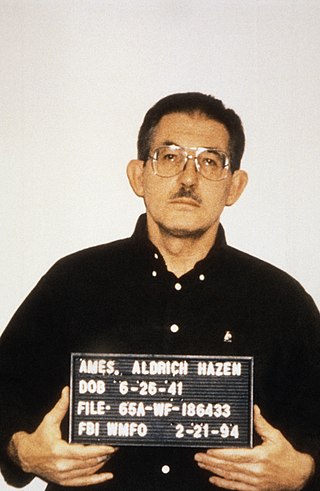
In 1995 it was revealed that the Central Intelligence Agency had delivered intelligence reports to the U.S. government between 1986 and 1994 which were based on agent reporting from confirmed or suspected Soviet operatives. From 1985 to his arrest in February 1994, CIA officer and KGB mole Aldrich Ames compromised Agency sources and operations in the Soviet Union and Eastern Europe, leading to the arrest of many CIA agents and the execution of at least ten of them. This allowed the KGB to replace the CIA agents with its own operatives or to force them to cooperate, and the double agents then funneled a mixture of disinformation and true material to U.S. intelligence. Although the CIA's Soviet-East European (SE) and Central Eurasian divisions knew or suspected the sources to be Soviet double agents, they nevertheless disseminated this "feed" material within the government. Some of these intelligence reports even reached Presidents Ronald Reagan and George H. W. Bush, as well as President-elect Bill Clinton.
References
- 1 2 3 Rose, P.K., "Two Strategic Intelligence Mistakes in Korea, 1950: Perceptions and Reality", Studies in Intelligence, archived from the original on June 13, 2007, retrieved 2007-12-19
- 1 2 Hatch, David A.; Robert Louis Benson, The Korean War: The SIGINT Background, National Security Agency, retrieved 2015-06-05
- ↑ "'Legacy of Ashes' Describes Founding of CIA". NPR.org.
- ↑ Finnegan, John (12 November 2002). "The Evolution of US Army HUMINT: Intelligence Operations in the Korean War" (PDF). CIA. Archived from the original (PDF) on 15 January 2022. Retrieved 30 April 2022.
- ↑ Gertz, Bill. "Chronology of North Korea's Missile Trade and Developments: 1996-1998". The Washington Times. via James Martin Center for Nonproliferation Studies, Middlebury Institute of International Studies of Monterey. 21 June 1996. p. A1, A22.
- ↑ "Chronology of North Korea's Missile Trade and Developments: 1996-1998". James Martin Center for Nonproliferation Studies. Middlebury Institute of International Studies of Monterey.
